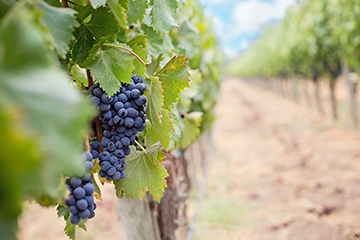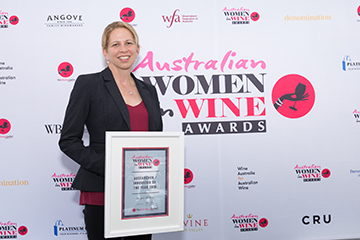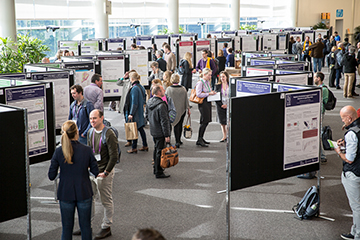Postdoctoral project sheds light on red wine colour stability
New analytical method for ‘mousy’ compound
Canned wine study gets boost from food innovation funding
Artist in residence |
|
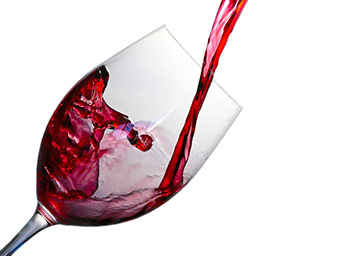 |
The Australian Network for Art & Technology (ANAT) is partnering with the AWRI on a new art + science residency. The AWRI will host an artist to work with its flavour chemistry and sensory research teams, led by Dr Leigh Francis, for 12 weeks during 2019. The residency is open to Australian artists working in any discipline and/or medium, and is believed to be the first wine science-focused artist’s residency in the world. More information for potential artists, including application documents, can be found on the ANAT website. Applications are due by 5 March 2019 and potential applicants can contact Vicki Sowry at ANAT (vicki@anat.org.au) or Dr Leigh Francis at the AWRI (leigh.francis@awri.com.au) for more information.
Since 2004, ANAT has brought artists and scientists together in research partnerships that have generated new knowledge, ideas and processes beneficial to both fields. Residencies have involved Australian science organisations hosting artists, leading to profound artistic and professional development for the participants, as well as building a sustainable support base for interdisciplinary creative collaboration in Australia. |
Postdoctoral project sheds light on red wine colour stabilityA visiting scientist from China, Dr Bo Teng, has recently completed a successful two-year postdoctoral project at the AWRI. Bo worked on red wine polymeric pigments and has drafted a manuscript on the kinetics of tannin-anthocyanin reactions, looking particularly at the quantity and stability of the polymeric pigments formed. His main findings were that larger tannins reacted more rapidly with anthocyanin, a trend observed for both skin and seed tannin. The polymeric pigments produced from seed or skin tannin showed different colloidal properties. When seed tannin reacted with anthocyanin, aggregate size increased and precipitation was initiated, resulting in colour loss. However, when skin tannin reacted with anthocyanin, the aggregation-precipitation phenomenon was not seen, and greater levels of polymeric pigment (and colour) were achieved. This study highlights a potential pathway for pigment loss during winemaking and ageing, which might be managed by preferential extraction of, or supplementation with, skin tannin to stabilise colour early during fermentation. The results also may explain, in part, why wine tannin is primarily derived from the grape skin, and why commercial seed tannin additions neither improve wine colour nor tannin concentration. |
|
New analytical method for ‘mousy’ compound |
|
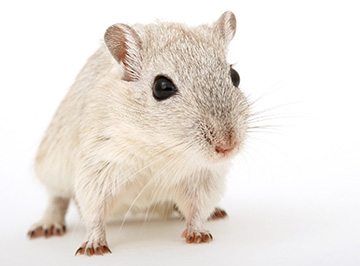 |
Mousy character is an off-flavour in wine that has been described as similar to the smell of caged mice. While there is wide variation in the ability of individuals to perceive this character, for sensitive individuals its presence can render a wine undrinkable. 2-Acetyltetrahydropyridine (ACTPY) is known to be one of the major compounds responsible for mousy off-flavour in wine. However, a practical and reliable method for measuring ACTPY in wine has not been available due to its unstable chemical nature and low odour threshold. The AWRI helpdesk team has recently developed a sensitive and simple method for the quantitation of ACTPY in wine, which has been published in the Journal of Chromatography A. The new method will be available for use in helpdesk investigations and research on mousy character in wine. |
Canned wine study gets boost from food innovation fundingThe AWRI has been successful in securing an innovation grant to support a study of the shelf life of wines packaged in cans. The study aims to understand the drivers behind aroma development in canned wines and identify ways to reduce the risk of short shelf life. This project will be delivered through an international industry consortium of eight major wine producers and packaging suppliers. The grant from the Enterprise Solution Centre Programme, administered by Food Innovation Australia Ltd, will provide matched funding to the study over a period of approximately 18 months. |
|
Smoke resourcesThe AWRI has a range of resources related to smoke exposure and can provide technical support and analysis to regions affected by fire events. Key resources are all accessible from the smoke taint page on the AWRI website and information about analysis options can be found in the AWRI Commercial Services smoke analysis FAQ. For assistance following a smoke event, contact the AWRI helpdesk on 08 8 313 6600 or helpdesk@awri.com.au. |
|
BMSB alert |
|
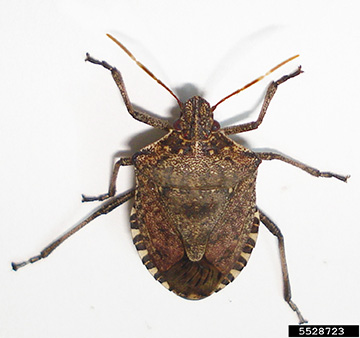 |
Australian Vignerons (now Australian Grape & Wine) recently issued an updated alert about detections of brown marmorated stink bug (BMSB) in Australia. Six post-border detections of BMSB have occurred since September 2018 in Queensland, Victoria and Western Australia, on a variety of imported cargo. Both live and dead bugs have been found. Grapegrowers and winemakers are urged to be vigilant about this pest, and to report any suspicious bugs to the Exotic Plant Pest Hotline on 1800 084 881. The Department of Agriculture website has an excellent guide to identifying stink bugs that shows the differences between BMSB and a range of other stink bugs found in Australia. |
Agrochemical updatesTwo agrochemical updates have recently been distributed by the AWRI – one on an emergency permit to use certain metalaxyl products for control of downy mildew and one on a new permit for control of European wasps. To sign up to receive the latest agrochemical information, subscribe to the AWRI’s eBulletin or for more information, refer to the agrochemicals page on the AWRI website or contact the AWRI helpdesk on helpdesk@awri.com.au or 08 8 313 6600. |
|
AWRI Annual Report |
|
 |
The 2018 AWRI Annual Report was distributed to levy payers and other stakeholders in December. It is also available online in pdf and ebook format. To request a hard copy, please contact Natalie Burgan on natalie.burgan@awri.com.au. |
AWITC registrations openRegistrations are now open for the 17th Australian Wine Industry Technical Conference in Adelaide from 21 to 24 July 2019. This year’s conference incorporates the Australian Grape & Wine Outlook Conference and the McWilliam’s Maurice O’Shea Award Dinner, and will be complemented by WineTech – the Australian grape and wine industry’s premier trade exhibition. The program includes 11 plenary sessions and 34 workshops, with the workshops all held on a dedicated day (Sunday 21 July), so as not to conflict with the main conference program. Early bird pricing is available until 12 April 2019. Delegates are encouraged to register early to secure tickets to their preferred workshops. For assistance, please contact the AWITC office on info@awitc.com.au or 08 83136821. |
|
AWAC ballot closing soonIf completing the AWRI’s Advanced Wine Assessment Course has always been on your ‘bucket list’, now is the time to make sure your name is in the ballot. Two AWAC courses will be held in May 2019. Register your details in the AWAC ballot now or check out the AWAC webpage for more information about the course. To be included in the ballot for AWAC 48 and 49, please register by Friday, 22 February. By registering now, you will also automatically be included in the ballots for future AWAC courses. Any queries? Contact the events team on 08 8313 6600 or events@awri.com.au. |
|
Wines sought for long-term benchmarkingThe AWRI is still seeking partners for a project that aims to follow a range of Australian wines for 10+ years across successive vintages. The project will use these wines to help understand emerging trends in Australian wine production as well how they develop with time. The AWRI is looking for partner wine producers to supply wine for this study on an ongoing basis. The commitment from producers would be to supply two cases of the latest vintage of the nominated wine on a yearly basis for at least the next 10 years. Each wine would be analysed post-bottling and at one, two, three, five, seven and ten-year time points for a wide range of chemical and microbiological markers. Each producer would receive a comprehensive analysis report at each time point and the anonymised overall results will be reported regularly as part of the project. Interested wine producers are invited to contact Dr Eric Wilkes (eric.wilkes@awri.com.au) for further information. |
|
Order the latest AWRI staff publications onlineAccessing the latest AWRI publications is easy. Visit the AWRI Publications web page to:
A list of AWRI publications published since the last eNews is included below: 2042 Bucher, T., Deroover, K., Stockley, C. Low-alcohol wine: A narrative review on consumer perception and behaviour. Beverages 4(4): 1-9; 2018 2043 Kontoudakis, N., Schmidtke, L.M., Bekker, M.Z., Smith, M., Smith, P.A., Scollary, G.R., Wilkes, E.N., Clark, A.C. Analytical strategies for measurement of different forms of Cu and Fe in wine: Comparison between approaches in relation to wine composition. Food Chem. 274: 89-99; 2019. 2044 Varela, J., Varela, C. Microbiological strategies to produce beer and wine with reduced ethanol concentration. Curr. Opin. Biotechnol. 56: 88-96; 2019. 2045 Godden, P. Ask the AWRI: Extended post-fermentation maceration. Aust. N.Z. Grapegrower Winemaker (657): 70-71; 2018. 2046 Johnson, D. Adapting to forces of global change. WBM (November/December): 66-67; 2018. 2047 Tang, J., Petrie, P.R., Whitty. M. Modelling relationships between visible winegrape berries and bunch maturity. Aust. J. Grape Wine Res. 25(1): 116-126; 2019. 2048 Roach, M.J., Johnson, D.L., Bohlmann, J., van Vuuren H.J.J., Jones, S.J.M., Pretorius, I.S., Schmidt, S.A., Borneman, A.R. Population sequencing reveals clonal diversity and ancestral inbreeding in the grapevine cultivar Chardonnay. PLoS Genetics 14 (11: e1007807): 1-24; 2018. 2049 Zhou, J., Zhang, Z., Lu, M., Xiao, H., Habili, N., Li, S. Complete nucleotide sequence of a new virus, peach chlorotic leaf spot virus, isolated from flat peach in China. Arch. Virol. 163: 3459-3461; 2018. 2050 Mierczynski, P., Mierczynska, A., Ciesielski, R., Mosinska, M., Nowosielska, M., Czylkowska, A., Maniukiewicz, W., Szynkowska, M.I., Vasilev, K. High active and selective Ni/CeO2–Al2O3 and Pd–Ni/CeO2–Al2O3 catalysts for oxy-steam reforming of methanol. Catalysts 8(9): 1-20; 2018. 2051 Roach, M.J., Schmidt, S.A., Borneman, A.R. Purge haplotigs: allelic contig reassignment for third-gen diploid genome assemblies. BMC Bioinformatics 19 (460): 1-10; 2018. 2052 Gombau, J., Nadal, P., Canela, N., Gómez-Alonso, S., García-Romero, E., Smith, P., Hermosín-Gutiérrez, I., Canals, J.M., Zamora, F. Measurement of the interaction between mucin and oenological tannins by Surface Plasmon Resonance (SPR); relationship with astringency. Food Chem. 275: 397-406; 2018. 2053 Bekker, M.Z., Kreitman, G.Y., Jeffery, D.W., Danilewicz, J.C. Liberation of hydrogen sulfide from dicysteinyl polysulfanes in model wine. J. Agric. Food Chem. 66 (51): 13483–13491; 2018. 2054 Li, S., Bindon, K., Bastian, S., Wilkinson, K. Impact of commercial oenotannin and mannoprotein products on the chemical and sensory properties of Shiraz wines made from sequentially harvested fruit. Foods 7(204): 1-17; 2018. 2055 Hayasaka, Y. Quantitative analysis of mousy off-flavour compound 2-acetyl tetrahydropyridine in wine using liquid chromatography tandem mass spectrometry interfaced with atmospheric chemical ionisation. J. Chromatogr. A 10.1016/j.chroma.2018.12.047; 2018. 2056 Petrie, P.R., Teng, B., Smith, P.A., Bindon, K.A. Managing high Baume juice using dilution. Wine Vitic. J. 34(1): 36-37; 2019. 2057 Costello, P., Jordans, C., Schmidt, S., Herderich, M., Johnson, D. Trials and tribulations of MLF: can timing of inoculations and MLF nutrients help? Wine Vitic. J. 34(1): 38-41; 2019. 2058 Dry, P. Pinotage. Wine Vitic. J. 34(1): 61; 2019. 2059 Longbottom, M. Reducing vineyard energy use. Aust. N.Z. Grapegrower Winemaker (659): 44-45; 2018. 2060 Coulter, A. Understanding molecular SO2 calculators. Aust. N.Z. Grapegrower Winemaker (660): 62-63; 2019. 2062 Stockley, C. Ask the AWRI: Will I live longer if I drink alcohol? Aust. N.Z. Grapegrower Winemaker (661): 68-69; 2019. 2063 Avramova, M., Grbin, P., Borneman, A., Albertin, W., Masneuf-Pomarède, I., Varela, C. Competition experiments between Brettanomyces bruxellensis strains reveal specific adaptation to sulfur dioxide and complex interactions at intraspecies level. FEMS Yeast Res. doi.org/10.1093/femsyr/foz010; 2019. 2064 Peter, J.J., Watson, T.L., Walker, M.E., Gardner, J.M., Lang, T.A., Borneman, A., Forgan, A., Tran, T., Jiranek, V. Use of a wine yeast deletion collection reveals genes that influence fermentation performance under low-nitrogen conditions. FEMS Yeast Res. doi: 10.1093/femsyr/foy009; 2018. 2065 Petrie, P.R., Wang, Y., Liu, S., Lam, S., Whitty, M.A., Skewes, M.A. The accuracy and utility of a low cost thermal camera and smartphone-based system to assess grapevine water status. Biosystems Eng. 179: 126-139; 2019. 2066 Di Lorenzo, C., Stockley, C., Colombo, F., Biella, S., Orgiu, F., Dell’Agli, M., Restani, P. The role of wine in modulating inflammatory processes: a review. Beverages 4(4): 1-17; 2018. 2067 Bucher, T., Deroover, K., Stockley, C. Low-alcohol wine: a narrative review on consumer perception and behaviour. Beverages 4(4): 1-9; 2018. 2068 Smith, H.M., Clarke, C.W., Smith, B.P., Carmody, B.M., Thomas, M.R., Clingeleffer, P.R., Powell, K.S. Genetic identification of SNP markers linked to a new grape phylloxera resistant locus in Vitis cinerea for marker-assisted selection. BMC Plant Biology 18: 1-13; 2018. 2069 Kutyna, D., Borneman, A.R. Heterologous production of flavour and aroma compounds in Saccharomyces cerevisiae. Genes 9(7): 1-15; 2018. 2070 Wahono, S.K., Cavallaro, A., Vasilev, K., Mierczynska, A. Plasma polymer facilitated magnetic technology for removal of oils from contaminated waters. Environ. Pollution 240: 725-732; 2018. |
|
AcknowledgementsThe AWRI acknowledges support from Australia’s grapegrowers and winemakers through their investment body, Wine Australia, with matching funds from the Australian Government. The AWRI is a member of the Wine Innovation Cluster in Adelaide, South Australia. |
|


